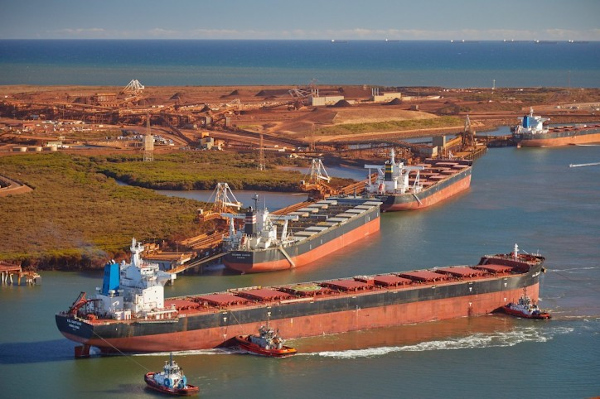Iron ore shipments from Indian ports in FY20 touched its peak in the last six years. At the end of February, the ports had carried 50 million tonnes of the key ingredient in steel making.
Iron ore has recorded a spurt of 43 per cent in volumes, registering the highest growth among all commodities. By contrast, fertilizer, liquid cargo and container cargo rose by 10.3 per cent, 2.5 per cent and 2.1 per cent respectively. Coal traffic at ports dipped by 8.3 per cent as demand subsided.
Since 2016-17 when ports handled 43 million tonnes (mt), iron ore cargo declined for two years, falling to 41 mt in 2017-18 and dropping further to 34 mt in 2018-19, a report by CARE Ratings showed, sourcing data from the Ministry of Shipping.
POL products (crude oil, petroleum products and LPG/LNG) and containers account for 70 per cent of the cargo handled by the Indian major ports. Iron ore, fertilizers and other cargo contribute the rest 30 per cent.
“Traffic in terms of cargo handled by major Indian ports has grown at a CAGR (compounded annual growth rate) of 4.7 per cent during FY 15-19 whereas traffic of iron ore, POL, container and coal has grown at 17.4 per cent, 5.3 per cent, 5 per cent and 2 per cent during the same aforementioned period. Fertilizer cargo traffic (finished and raw materials) on the other hand has fallen by 1.7 per cent during FY15-19. The fall in fertilizer cargo traffic can be attributable to increase in domestic production thus shifting the reliance from its imports”, the CARE Ratings report noted.
Capacity addition over the last four years has grown at a robust rate of 14.8 per cent CAGR during FY15-19. Increasing trade activities and private participation in building the port infrastructure has supported the increase in capacity. However it has not resulted in a commensurate increase in the utilization rates as it has fallen from a 67 per cent utilization rate during FY15 to 46 per cent during FY19. During FY20 (April-December) capacity utilization rates has fallen even further to 34 per cent due to the weakness in global trade since the start of FY20.
Cargo traffic handled by the domestic ports has grown at a CAGR of 4.7 per cent during FY15-19. In FY20 (April-February) period cargo traffic handled by Indian ports has decelerated and grown by only a mere 1.4 per cent as compared with the 2.8 per cent growth achieved in the corresponding period in the previous financial year. Escalated tensions and weakness in global trade due to the trade/tariff wars between China and the US and the prevailing slowdown in the Indian economy has led to the subdued trade growth.
Source: Dry Cago
Image Courtesy: VesselFinder
You may also like
-
Trade Connect E-platform For Exports Is Single Window, Fast, Accessible And Transformational: Shri Piyush Goyal
-
Dot Simplifies Approval Processes For Telecom Licenses And Wireless Equipment
-
Coal Production and Supply Trends on Positive Trajectory
-
Union Minister To Release Booklets On Promotion Of Indigenous Species & Conservation Of States Fishes
-
2nd India-Japan Finance Dialogue held in Tokyo on 6th September, 2024
